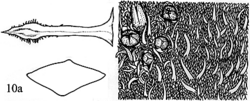Xanthorrhoea glauca subsp. glauca D.J.Bedford APNI* 
Description: Leaves ± transverse-rhombic to narrowly transverse-rhombic, apically transverse-linear, mostly 3–4 mm wide in T.S., 1–2.6 mm thick, blue-green. Scape 27–46 mm diam.; spike 100–200 cm long, 4–6 cm diam.; cluster bracts with hairs only towards base of outer surface, margins glabrous; packing bracts acute or triangular. Outer tepals triangular to narrow-triangular, with a beak to 1.5 mm long.
Flowering: Flowers June–October
Distribution and occurrence: On steep slopes and ridges mainly in rich basaltic soils and, at some sites in serpentine soils, and in deep coastal sand; from Newcastle to Byron Bay and inland to Ashford.
NSW subdivisions: NC, NT, NWS
Other Australian states: Qld
Populations on the coastal dunes from Byron Bay to Newcastle hybridize with X. fulva and X. latifolia in distinct short-range hybrid swarms. These populations growing on sand cannot be distinguished morphologically from populations on the more typical rich basaltic soil substrates, although it appears unlikely for the one species to occupy such different habitats. [previously regarded as a hybrid between X. australis and X. latifolia]
Text by D. J. Bedford
Taxon concept: Flora of NSW 4 (1993)
APNI* Provides a link to the Australian Plant Name Index (hosted by the Australian National Botanic Gardens) for comprehensive bibliographic data
***The AVH map option provides a detailed interactive Australia wide distribution map drawn from collections held by all major Australian herbaria participating in the Australian Virtual Herbarium project.
|


